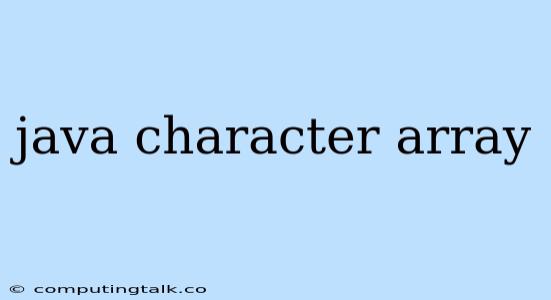Working with Characters in Java: A Comprehensive Guide to Character Arrays
In the world of Java programming, characters are the fundamental building blocks of text. Whether you're dealing with simple strings or complex data structures, understanding how to work with characters is essential. One powerful tool for manipulating characters in Java is the character array.
Character arrays are a flexible and efficient way to store and process sequences of characters. They offer a different perspective on working with text compared to the more common String class, providing greater control over individual characters.
Understanding Character Arrays in Java
What is a Character Array?
A character array in Java is simply an array that holds individual characters. Each element in the array represents a single character, allowing you to access, modify, and manipulate these characters directly.
Declaring and Initializing Character Arrays:
char[] myCharArray = new char[10]; // Declare a character array with a size of 10
char[] myCharArray = {'H', 'e', 'l', 'l', 'o'}; // Initialize with specific characters
Accessing and Modifying Characters:
You can access and modify individual characters within a character array using their index, similar to any other array in Java.
char[] myCharArray = {'H', 'e', 'l', 'l', 'o'};
char firstCharacter = myCharArray[0]; // Access the first character
myCharArray[1] = 'a'; // Modify the second character
Practical Applications of Character Arrays
Character arrays in Java are used in various scenarios, including:
-
String Manipulation: Character arrays provide a low-level way to work with strings, allowing you to perform operations such as character replacement, searching, and formatting.
-
Data Validation: You can use character arrays to validate user input, checking for specific character types, patterns, and limitations.
-
Cryptography: Character arrays are essential in cryptography algorithms, where you manipulate individual characters for encryption and decryption.
-
Text Processing: Character arrays enable you to process large text files efficiently by breaking them down into individual characters.
Advantages of Using Character Arrays
Using character arrays in Java offers several advantages:
-
Direct Access to Individual Characters: This allows for fine-grained control over each character within the array.
-
Memory Efficiency: Character arrays are generally more memory-efficient than
Stringobjects, especially when working with small strings. -
Flexibility: Character arrays allow you to manipulate characters freely, including inserting, deleting, and replacing them as needed.
Considerations When Using Character Arrays
While character arrays offer flexibility, there are a few key considerations to keep in mind:
-
Mutable: Character arrays are mutable, meaning their contents can be changed after they are created.
-
Null Termination: Unlike strings, character arrays are not automatically null-terminated. You'll need to handle the end of the array yourself.
-
Character Encoding: Be aware of the character encoding being used. Java typically uses Unicode, which can impact character representation and manipulation.
Examples and Use Cases
1. Converting a String to a Character Array:
String myString = "Hello World";
char[] myCharArray = myString.toCharArray(); // Convert the string to a character array
2. Checking for Vowels:
char[] vowels = {'a', 'e', 'i', 'o', 'u'};
char character = 'A';
boolean isVowel = false;
for (char vowel : vowels) {
if (character == vowel) {
isVowel = true;
break;
}
}
3. Reversing a String:
String myString = "Reverse";
char[] charArray = myString.toCharArray();
int start = 0;
int end = charArray.length - 1;
while (start < end) {
char temp = charArray[start];
charArray[start] = charArray[end];
charArray[end] = temp;
start++;
end--;
}
String reversedString = new String(charArray);
Conclusion
Character arrays in Java provide a powerful and versatile approach to working with individual characters. By understanding their structure, advantages, and considerations, you can leverage their flexibility to perform various string manipulation tasks, data validation, and other operations. Remember to choose the right data structure based on your specific needs and ensure you handle character encoding and null termination appropriately.
